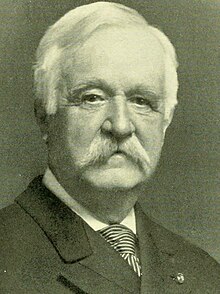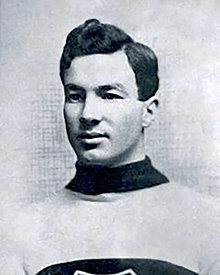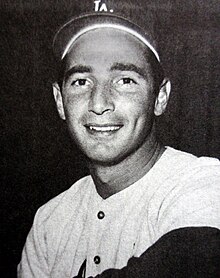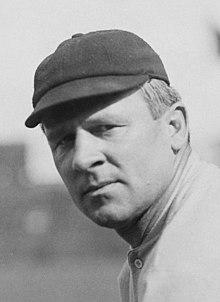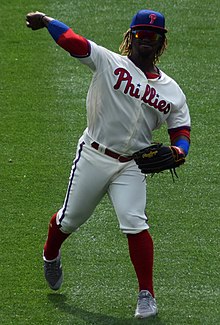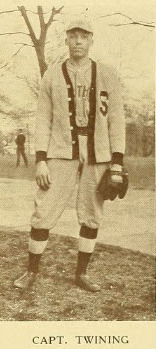Portal:Baseball
Portal maintenance status: (June 2018)
|
| Main page | Content, Categories & Topics | WikiProjects & Things you can do |
The Baseball Portal
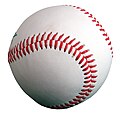
Baseball is a bat-and-ball sport played between two teams of nine players each, taking turns batting and fielding. The game occurs over the course of several plays, with each play generally beginning when a player on the fielding team, called the pitcher, throws a ball that a player on the batting team, called the batter, tries to hit with a bat. The objective of the offensive team (batting team) is to hit the ball into the field of play, away from the other team's players, allowing its players to run the bases, having them advance counter-clockwise around four bases to score what are called "runs". The objective of the defensive team (referred to as the fielding team) is to prevent batters from becoming runners, and to prevent runners' advance around the bases. A run is scored when a runner legally advances around the bases in order and touches home plate (the place where the player started as a batter).
The opposing teams switch back and forth between batting and fielding; the batting team's turn to bat is over once the fielding team records three outs. One turn batting for each team constitutes an inning. A game is usually composed of nine innings, and the team with the greater number of runs at the end of the game wins. Most games end after the ninth inning, but if scores are tied at that point, extra innings are usually played. Baseball has no game clock, though some competitions feature pace-of-play regulations such as the pitch clock to shorten game time.
Baseball evolved from older bat-and-ball games already being played in England by the mid-18th century. This game was brought by immigrants to North America, where the modern version developed. Baseball's American origins, as well as its reputation as a source of escapism during troubled points in American history such as the American Civil War and the Great Depression, have led the sport to receive the moniker of "America's Pastime"; since the late 19th century, it has been unofficially recognized as the national sport of the United States, though in modern times is considered less popular than other sports, such as American football. In addition to North America, baseball spread throughout the rest of the Americas and the Asia–Pacific in the 19th and 20th centuries, and is now considered the most popular sport in parts of Central and South America, the Caribbean, and East Asia, particularly in Japan, South Korea, and Taiwan. (Full article...)
 Featured articles - load new batch
Featured articles - load new batch
-
Image 1
Morgan Gardner Bulkeley (December 26, 1837 – November 6, 1922) was an American politician of the Republican Party, businessman, and insurance executive. In 1876, he served as the first president of baseball's National League and, because of that, was inducted into the National Baseball Hall of Fame in 1937, a choice that remains controversial, since his time as a baseball executive was short.
Bulkeley was born in East Haddam, Connecticut. His father was Judge Eliphalet Adams Bulkeley, a prominent local lawyer and businessman, who became the first president of the Aetna Life Insurance Company. The family moved to Hartford, where Morgan Bulkeley was educated, before he took a job in the city of Brooklyn, New York. He served briefly in the American Civil War, where he saw no combat. When his father died in 1872, he moved back to Hartford and became a bank president and a board member of Aetna, becoming its president in 1879, a post he held the rest of his life. (Full article...) -
Image 2
James Howard Thome (/ˈtoʊmi/; TOH-mee; born August 27, 1970) is an American former professional baseball corner infielder and designated hitter, who played in Major League Baseball (MLB) for 22 seasons (1991–2012). A prolific power hitter, Thome hit 612 home runs during his career—the eighth-most all time. He amassed a total of 2,328 hits and 1,699 runs batted in (RBIs). His career batting average was .276. He was a member of five All-Star teams and won a Silver Slugger Award in 1996.
Thome grew up in Peoria, Illinois, as part of a large blue-collar family of athletes, who predominantly played baseball and basketball. After attending Illinois Central College, he was drafted by the Indians in the 1989 draft, and made his big league debut in 1991. Early in his career, Thome played third base, before eventually becoming a first baseman. With the Indians, he was part of a core of players that led the franchise to five consecutive playoff appearances in the 1990s, including World Series appearances in 1995 and 1997. Thome spent over a decade with Cleveland, before leaving via free agency after the 2002 season, to join the Philadelphia Phillies, with whom he spent the following three seasons. Traded to the Chicago White Sox before the 2006 season, he won the American League (AL) Comeback Player of the Year Award that year and joined the 500 home run club during his three-season tenure with the White Sox. By this point in his career, back pain limited Thome to being a designated hitter. After stints with the Los Angeles Dodgers and Minnesota Twins, he made brief returns to Cleveland and Philadelphia, before ending his career with the Baltimore Orioles. Upon retiring, Thome accepted an executive position with the White Sox. (Full article...) -
Image 3Los Angeles Angels center fielder Mike Trout hits a home run on a pitch from New York Mets pitcher Tommy Milone on May 21, 2017.
Baseball is a bat-and-ball sport played between two teams of nine players each, taking turns batting and fielding. The game occurs over the course of several plays, with each play generally beginning when a player on the fielding team, called the pitcher, throws a ball that a player on the batting team, called the batter, tries to hit with a bat. The objective of the offensive team (batting team) is to hit the ball into the field of play, away from the other team's players, allowing its players to run the bases, having them advance counter-clockwise around four bases to score what are called "runs". The objective of the defensive team (referred to as the fielding team) is to prevent batters from becoming runners, and to prevent runners' advance around the bases. A run is scored when a runner legally advances around the bases in order and touches home plate (the place where the player started as a batter).
The initial objective of the batting team is to have a player reach first base safely; this generally occurs either when the batter hits the ball and reaches first base before an opponent retrieves the ball and touches the base, or when the pitcher persists in throwing the ball out of the batter's reach. Players on the batting team who reach first base without being called "out" can attempt to advance to subsequent bases as a runner, either immediately or during teammates' turns batting. The fielding team tries to prevent runs by using the ball to get batters or runners "out", which forces them out of the field of play. The pitcher can get the batter out by throwing three pitches which result in strikes, while fielders can get the batter out by catching a batted ball before it touches the ground, and can get a runner out by tagging them with the ball while the runner is not touching a base. (Full article...) -
Image 4
Tyler Wayne Skaggs (July 13, 1991 – July 1, 2019) was an American left-handed professional baseball starting pitcher who played in Major League Baseball (MLB) for the Arizona Diamondbacks and Los Angeles Angels from 2012 until his death in 2019.
A native of Woodland Hills, California, and a graduate of Santa Monica High School, Skaggs was a supplemental first-round selection for the Angels in the 2009 Major League Baseball draft. He was traded to the Diamondbacks the following year as part of an exchange for pitcher Dan Haren and rose through Arizona's farm system. After two consecutive appearances at the All-Star Futures Game in 2011 and 2012, Skaggs made his major league debut on August 22, 2012, against the Miami Marlins. He remained with the Diamondbacks through the end of the season, but was optioned to the minor leagues in 2013. (Full article...) -
Image 5

KARE (channel 11) is a television station licensed to Minneapolis, Minnesota, United States, serving as the Twin Cities area's NBC affiliate. Owned by Tegna Inc., the station maintains studios on Olson Memorial Highway (MN 55) in Golden Valley and a transmitter at the Telefarm site in Shoreview, Minnesota.
Channel 11 began broadcasting on September 1, 1953. It was originally shared by WMIN-TV in St. Paul and WTCN-TV in Minneapolis; the two stations shared an affiliation with ABC and alternated presenting local programs. In 1955, Consolidated Television and Radio bought both stations and merged them as WTCN-TV from the Minneapolis studios in the Calhoun Beach Hotel. The station presented several regionally and nationally notable children's shows in its early years as well as local cooking, news, and sports programs. Time Inc. purchased the station in 1957. Under its ownership, ABC switched its affiliation to KMSP-TV (channel 9), leaving channel 11 to become an independent station that broadcast games of the Minnesota Twins baseball team, movies, and syndicated programs. This continued under two successive owners: Chris-Craft Industries and Metromedia. By the late 1970s, WTCN was one of the nation's most financially successful independent stations. (Full article...) -
Image 6
A picture of a Wii Sports disc
Wii Sports is a 2006 sports simulation video game developed and published by Nintendo for the Wii video game console. The game was released in North America along with the Wii on November 19, 2006, and in Japan, Australia, and Europe the following month. It was included as a pack-in game with the console in all territories except Japan, making it the first sports game included with the launch of a Nintendo system since Mario's Tennis for the Virtual Boy in 1995. The game was later released on its own as part of the Nintendo Selects collection of games.
Wii Sports is a collection of five sports simulations designed to demonstrate the motion-sensing capabilities of the Wii Remote. The five sports included are tennis, baseball, bowling, golf, and boxing. Players use the Wii Remote to mimic actions performed in real-life sports, such as swinging a tennis racket or rolling a bowling ball. The rules for each game are simplified to make them more accessible to new players. The game also features training and fitness modes that monitor players' progress in the sports. (Full article...) -
Image 7
Robert William Andrew Feller (November 3, 1918 – December 15, 2010), nicknamed "the Heater from Van Meter", "Bullet Bob", and "Rapid Robert", was an American baseball pitcher who played 18 seasons in Major League Baseball (MLB) for the Cleveland Indians between 1936 and 1956. In a career spanning 570 games, Feller pitched 3,827 innings and posted a win–loss record of 266–162, with 279 complete games, 44 shutouts, and a 3.25 earned run average (ERA). His career 2,581 strikeouts were third all-time upon his retirement.
A prodigy who bypassed baseball's minor leagues, Feller made his debut with the Indians at the age of 17. His career was interrupted by four years of military service (1942–1945) as a United States Navy Chief Petty Officer aboard USS Alabama during World War II. Feller became the first pitcher to win 24 games in a season before the age of 21. He threw no-hitters in 1940, 1946, and 1951, and 12 one-hitters, both records at his retirement. He helped the Indians win a World Series title in 1948 and an American League-record 111 wins and the pennant in 1954. Feller led the American League in wins six times and in strikeouts seven times. In 1946 he recorded 348 strikeouts, the most since 1904 and then believed to be a record. (Full article...) -
Image 8

James Robert "Loafer" McAleer (July 10, 1864 – April 29, 1931) was an American center fielder, manager, and stockholder in Major League Baseball who assisted in establishing the American League. He spent most of his 13-season playing career with the Cleveland Spiders, and went on to manage the Cleveland Blues, St. Louis Browns, and Washington Senators. Shortly before his retirement, he became a major shareholder in the Boston Red Sox. His career ended abruptly. During his brief tenure as co-owner of the Red Sox, McAleer quarreled with longtime friend and colleague Ban Johnson, president of the American League. In the wake of this disagreement, he sold off his shares in the Red Sox and broke off his relationship with Major League Baseball.
McAleer's rift with Johnson, along with his sudden retirement, damaged his professional reputation, and he received little recognition for his contributions to baseball. Today, he is most often remembered for initiating the customary request that the President of the United States throw out the first ball of the season. (Full article...) -
Image 9Paschal before a game during the 1925 New York Yankees season
Benjamin Edwin Paschal (October 13, 1895 – November 10, 1974) was an American baseball outfielder who played eight seasons in Major League Baseball from 1915 to 1929, mostly for the New York Yankees. After two "cup of coffee" stints with the Cleveland Indians in 1915 and the Boston Red Sox in 1920, Paschal spent most of his career as the fourth outfielder and right-handed pinch hitter of the Yankees' Murderers' Row championship teams of the late 1920s. Paschal is best known for hitting .360 in the 1925 season while standing in for Babe Ruth, who missed the first 40 games with a stomach ailment.
During his time in baseball, Paschal was described as a five-tool player who excelled at running, throwing, fielding, hitting for average, and power. However, his playing time with the Yankees was limited because they already had future Baseball Hall of Famers Ruth and Earle Combs, and star Bob Meusel, in the outfield. Paschal was considered one of the best bench players in baseball during his time with the Yankees, and sportswriters wrote how he would have started for most other teams in the American League. He was one of the best pinch hitters in the game during the period, at a time when the term was still relatively new to baseball. (Full article...) -
Image 10

Ian Michael Chappell (born 26 September 1943) is a former cricketer who played for South Australia and Australia. Known as "Chappelli", he is considered as one of the greatest captains the game has seen. He captained Australia between 1971 and 1975 before taking a central role in the breakaway World Series Cricket organisation. Born into a cricketing family—his grandfather and brother also captained Australia—Chappell made a hesitant start to international cricket playing as a right-hand middle-order batsman and spin bowler. He found his niche when promoted to bat at number three. Chappell's blunt verbal manner led to a series of confrontations with opposition players and cricket administrators; the issue of sledging first arose during his tenure as captain, and he was a driving force behind the professionalisation of Australian cricket in the 1970s. He was the captain of the Australian squad which finished as runners-up at the 1975 Cricket World Cup.
John Arlott called him "a cricketer of effect rather than the graces". An animated presence at the batting crease, he constantly adjusted his equipment and clothing, and restlessly tapped his bat on the ground as the bowler ran in. Basing his game on a sound defence learned during many hours of childhood lessons, Chappell employed the drive and square cut to full effect. He had an idiosyncratic method of playing back and across to a ball of full length and driving wide of mid-on, but his trademark shot was the hook, saying "three bouncers an over should be worth 12 runs to me". A specialist slip fielder, he was the fourth player to take one hundred Test catches. (Full article...) -
Image 11
George Herman "Babe" Ruth (February 6, 1895 – August 16, 1948) was an American professional baseball player whose career in Major League Baseball (MLB) spanned 22 seasons, from 1914 through 1935. Nicknamed "the Bambino" and "the Sultan of Swat", he began his MLB career as a star left-handed pitcher for the Boston Red Sox, but achieved his greatest fame as a slugging outfielder for the New York Yankees. Ruth is regarded as one of the greatest sports heroes in American culture and is considered by many to be the greatest baseball player of all time. In 1936, Ruth was elected to the Baseball Hall of Fame as one of its "first five" inaugural members.
At age seven, Ruth was sent to St. Mary's Industrial School for Boys, a reformatory where he was mentored by Brother Matthias Boutlier of the Xaverian Brothers, the school's disciplinarian and a capable baseball player. In 1914, Ruth was signed to play Minor League baseball for the Baltimore Orioles but was soon sold to the Red Sox. By 1916, he had built a reputation as an outstanding pitcher who sometimes hit long home runs, a feat unusual for any player in the dead-ball era. Although Ruth twice won 23 games in a season as a pitcher and was a member of three World Series championship teams with the Red Sox, he wanted to play every day and was allowed to convert to an outfielder. With regular playing time, he broke the MLB single-season home run record in 1919 with 29. (Full article...) -
Image 12Ross with the Montreal Wanderers, circa 1907–18
Arthur Howey Ross (January 13, 1885 – August 5, 1964) was a Canadian professional ice hockey player and executive from 1905 until 1954. Regarded as one of the best defenders of his era by his peers, he was one of the first to skate with the puck up the ice rather than pass it to a forward. He was on Stanley Cup championship teams twice in a playing career that lasted thirteen seasons; in January 1907 with the Kenora Thistles and 1908 with the Montreal Wanderers. Like other players of the time, Ross played for several different teams and leagues, and is noted for his time with the Wanderers while they were members of the National Hockey Association (NHA) and its successor, the National Hockey League (NHL). In 1911, he led one of the first organized player strikes over increased pay. When the Wanderers' home arena burned down in January 1918, the team ceased operations and Ross retired as a player.
After several years as an on-ice official, he was named head coach of the Hamilton Tigers for one season. When the Boston Bruins were formed in 1924, Ross was hired as the first coach and general manager of the team. He later coached the team on three separate occasions until 1945, and stayed as general manager until his retirement in 1954. Ross helped the Bruins finish first place in the league ten times and win the Stanley Cup three times; Ross personally coached the team to two of those victories. After being hired by the Bruins, Ross, along with his wife and two sons, moved to a suburb of Boston, and he became an American citizen in 1938. He died near Boston in 1964. (Full article...) -
Image 13
Sanford Koufax (/ˈkoʊfæks/; né Braun; born December 30, 1935), nicknamed "the Left Arm of God", is an American former baseball pitcher who played 12 seasons in Major League Baseball (MLB) for the Brooklyn/Los Angeles Dodgers from 1955 to 1966. Widely regarded as one of the greatest pitchers in baseball history, Koufax was the first three-time winner of the Cy Young Award, each time winning unanimously and the only pitcher to do so when a single award was given for both the leagues; he was also named the National League Most Valuable Player in 1963. Retiring at the age of 30 due to chronic pain in his pitching elbow, Koufax was elected to the Baseball Hall of Fame in his first year of eligibility in 1972 at the age of 36, the youngest player ever elected.
Born in Brooklyn, New York, Koufax was primarily a basketball player in his youth and had pitched in only a few games before signing with the Brooklyn Dodgers at age 19. Due to the bonus rule he signed under, Koufax never pitched the minor leagues. His lack of pitching experience caused manager Walter Alston to distrust Koufax, who saw inconsistent playing time during his first six seasons. As a result, though he often showed flashes of brilliance, Koufax struggled early on. Frustrated with the way he was being managed by the Dodgers, he almost quit after the 1960 season. After making adjustments prior to the 1961 season, Koufax quickly rose to become the most dominant pitcher in the major leagues, as well as the first major sports star on the West Coast. He was an All-Star in each of his last six seasons, leading the National League (NL) in earned run average each of his last five years, in strikeouts four times, and in wins and shutouts three times each. He was the first pitcher in the live-ball era to post an earned run average below 2.00 in three different qualifying seasons, and the first ever to record a 300-strikeout season three times. (Full article...) -
Image 14

Lawrence Winchester Wetherby (January 2, 1908 – March 27, 1994) was an American politician who served as Lieutenant Governor and Governor of Kentucky. He was the first of only two governors in state history born in Jefferson County, despite the fact that Louisville (the county seat) is the state's most populous city. The second governor born in Jefferson County is the incumbent governor, Andy Beshear.
After graduating from the University of Louisville, Wetherby held several minor offices in the Jefferson County judicial system before being elected lieutenant governor in 1947. He was called Kentucky's first "working" lieutenant governor because Governor Earle C. Clements asked him to carry out duties beyond his constitutional responsibility to preside over the state Senate, such as preparing the state budget and attending the Southern Governors Conference. In 1950, Clements resigned to assume a seat in the U.S. Senate, elevating Wetherby to governor. Wetherby won immediate acclaim by calling a special legislative session to increase funding for education and government benefits from the state's budget surplus. In 1951, he won a four-year full term as governor, during which he continued and expanded many of Clements' programs, including increased road construction and industrial diversification. He endorsed the Supreme Court's 1954 desegregation order in the case of Brown v. Board of Education and appointed a biracial commission to oversee the successful integration of the state's schools. As chairman of the Southern Governors Conference in 1954 and 1955, he encouraged other southern governors to accept and implement desegregation. (Full article...) -
Image 15
John Joseph McGraw (April 7, 1873 – February 25, 1934) was an American Major League Baseball (MLB) player and manager who was for almost thirty years manager of the New York Giants. He was also the third baseman of the pennant-winning 1890s Baltimore Orioles teams, noted for their innovative, aggressive play.
McGraw was born into poverty in Truxton, New York. He found an escape from his hometown and a bad family situation through baseball, beginning a quick rise through the minor leagues that led him to the Orioles at the age of 18. Under the tutelage of manager Ned Hanlon, the Orioles of the 1890s won three National League (NL) pennants; McGraw was one of the stalwarts of the team alongside Wee Willie Keeler, Hughie Jennings, and Wilbert Robinson. The Orioles perfected the hit and run play and popularized the Baltimore chop; they also sought to win by intimidating the opposing team and the umpire. (Full article...)
General images - load new batch
-
Image 1Alexander Cartwright, father of modern baseball (from History of baseball)
-
Image 2Cy Young—the holder of many major league career marks, including wins and innings pitched, as well as losses—in 1908. MLB's annual awards for the best pitcher in each league are named for Young. (from Baseball)
-
Image 3Baserunners generally stand a short distance away from their base between pitches, preparing themselves to either go back or steal the next base. (from Baseball rules)
-
Image 4A well-worn baseball (from Baseball)
-
Image 5The standard fielding positions (from Baseball rules)
-
Image 6Jackie Robinson in 1945, with the era's Kansas City Royals, a barnstorming squad associated with the Negro American League's Kansas City Monarchs (from Baseball)
-
Image 7A first baseman receives a pickoff throw, as the runner dives back to first base. (from Baseball)
-
Image 8Pitchers are generally substituted during mound visits (team gatherings at the pitcher's mound). (from Baseball rules)
-
Image 12Baseball games sometimes end in a walk-off home run, with the batting team usually gathering at home plate to celebrate the scoring of the winning run(s). (from Baseball rules)
-
Image 13Rickey Henderson—the major leagues' all-time leader in runs and stolen bases—stealing third base in a 1988 game (from Baseball)
-
Image 14Pesäpallo, a Finnish variation of baseball, was invented by Lauri "Tahko" Pihkala in the 1920s, and after that, it has changed with the times and grown in popularity. Picture of Pesäpallo match in 1958 in Jyväskylä, Finland. (from Baseball)
-
Image 16By the 1860s Civil War, baseball (bottom) had overtaken its fellow bat-and-ball sport cricket (top) in popularity within the United States. (from History of baseball)
-
Image 17The American Tobacco Company's line of baseball cards featured shortstop Honus Wagner of the Pittsburgh Pirates from 1909 to 1911. In 2007, the card shown here sold for $2.8 million. (from Baseball)
-
Image 18Sadaharu Oh managing the Japan national team in the 2006 World Baseball Classic. Playing for the Central League's Yomiuri Giants (1959–80), Oh set the professional world record for home runs with 868. (from History of baseball)
-
Image 19Two players on the baseball team of Tokyo, Japan's Waseda University in 1921 (from Baseball)
-
Image 20The NL champion New York Giants baseball team, 1913. Fred Merkle, sixth in line, had committed a baserunning gaffe in a crucial 1908 game that became famous as Merkle's Boner. (from History of baseball)
-
Image 21The typical motion of a right-handed pitcher (from Baseball rules)
-
Image 23A runner sliding into home plate and scoring. (from Baseball)
-
Image 24Defensive positions on a baseball field, with abbreviations and scorekeeper's position numbers (not uniform numbers) (from Baseball)
-
Image 25The strike zone, which determines the outcome of most pitches, varies in vertical length depending on the batter's typical height while swinging. (from Baseball rules)
-
Image 271906 World Series, infielders playing "in" for the expected bunt and the possible play at the plate with the bases loaded (from Baseball rules)
-
Image 28Fenway Park, home of the Boston Red Sox. The Green Monster is visible beyond the playing field on the left. (from Baseball)
-
Image 29Jackie Robinson in 1945, with the era's Kansas City Royals, a barnstorming squad associated with the Negro American League's Kansas City Monarchs (from History of baseball)
-
Image 30A pitcher handing off the ball after being taken out of the game during a mound meeting. (from Baseball)
-
Image 33Japanese-Americans spectating a World War II-era game while in an internment camp. America's ties to immigrants and to Japan have been deeply shaped by a shared baseball heritage. (from History of baseball)
-
Image 34Pick-off attempt on runner (in red) at first base (from Baseball rules)
-
Image 35Diagram of a baseball field Diamond may refer to the square area defined by the four bases or to the entire playing field. The dimensions given are for professional and professional-style games. Children often play on smaller fields. (from Baseball)
-
Image 362013 World Baseball Classic championship match between the Dominican Republic and Puerto Rico, March 20, 2013 (from Baseball)
-
Image 37A game from the Cantigas de Santa Maria, c. 1280, involving tossing a ball, hitting it with a stick and competing with others to catch it (from History of baseball)
-
Image 38A New York Yankees batter (Andruw Jones) and a Boston Red Sox catcher at Fenway Park (from Baseball)
-
Image 39In May 2010, the Philadelphia Phillies' Roy Halladay pitched the 20th major league perfect game. That October, he pitched only the second no-hitter in MLB postseason history. (from History of baseball)
-
Image 40A batter follows through after swinging at a pitched ball. (from Baseball rules)
-
Image 41Cover of Official Base Ball Rules, 1921 edition, used by the American League and National League (from Baseball rules)
-
Image 43An Afghan girl playing baseball in August 2002 (from Baseball)
-
Image 44Sadaharu Oh managing the Japan national team in the 2006 World Baseball Classic. Playing for the Central League's Yomiuri Giants (1959–80), Oh set the professional world record for home runs. (from Baseball)
-
Image 45The strike zone determines the result of most pitches, and varies in vertical length for each batter. (from Baseball)
 Good articles - load new batch
Good articles - load new batch
-
Image 1
Cindy Lou McCain (née Hensley; born May 20, 1954) is an American diplomat, businesswoman, and humanitarian who is the executive director of the World Food Programme. McCain previously served as U.S. Ambassador to the United Nations Agencies for Food and Agriculture from 2021 to 2023. She is the widow of U.S. Senator John McCain from Arizona, who was the 2008 Republican presidential nominee.
McCain was born and raised in Phoenix, Arizona, and is a daughter of wealthy beer distributor Jim Hensley. After receiving bachelor's and master's degrees from the University of Southern California, she became a special education teacher. She married John McCain in 1980, and the couple moved to Arizona in 1981, where her husband was elected to the United States Congress the following year and reelected five more times. The couple had three children together, in addition to adopting another. From 1988 to 1995, she founded and operated a nonprofit organization, the American Voluntary Medical Team, which organized trips by medical personnel to disaster-stricken or war-torn third-world areas. (Full article...) -
Image 2

Forbes Field was a baseball park in the Oakland neighborhood of Pittsburgh, Pennsylvania, from 1909 to June 28, 1970. It was the third home of the Pittsburgh Pirates, the city's Major League Baseball (MLB) team, and the first home of the Pittsburgh Steelers, the city's National Football League (NFL) franchise. From 1909 to 1924, the stadium also served as the home football field for the University of Pittsburgh "Pitt" Panthers. The stadium sat on Forbes Avenue, named for British general John Forbes, who fought in the French and Indian War and named the city in 1758.
The US$1 million ($33.9 million today) project was launched by Pittsburgh Pirates' owner Barney Dreyfuss to replace his franchise's second home, Exposition Park. The stadium was made of concrete and steel, the first such stadium in the National League and third in Major League Baseball, in a bid to be more durable than wooden ballparks. The Pirates opened Forbes Field on June 30, 1909, against the Chicago Cubs, and played the final game against the Cubs on June 28, 1970. The field itself featured a large playing surface, with the batting cage placed in the deepest part of center field during games. Seating was altered multiple times throughout the stadium's life; at times fans were permitted to sit on the grass in the outfield during overflow crowds. The Pirates won three World Series while at Forbes Field; the Pittsburgh Panthers football team had five undefeated seasons before moving in 1924. In 1958, broadcaster Bob Prince dubbed Forbes Field "The House of Thrills" for the then-resurgent Pirates and several games that saw late-inning heroics. (Full article...) -
Image 3Hand with the California Angels in 1973
Richard Allen Hand (born July 10, 1948) is an American former professional baseball player. A right-handed pitcher, he played for four seasons in Major League Baseball (MLB) for the Cleveland Indians, Texas Rangers and California Angels.
Born in Bellevue, Washington, Hand graduated from Lincoln High School in Seattle and attended the University of Puget Sound. Drafted three times, he signed with the Indians when they selected him in the supplementary phase of the 1969 MLB Draft. Named the number three pitcher in the starting rotation in 1970, he posted a 3.83 earned run average (ERA) in 35 appearances. Hand was sent to the minor leagues for part of 1971; he threw a no-hitter for the Wichita Aeros but posted a 5.79 ERA in the major leagues. (Full article...) -
Image 4
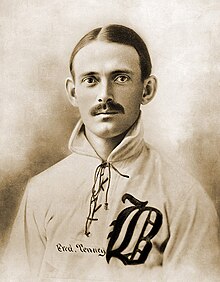
Frederick Tenney (November 26, 1871 – July 3, 1952) was an American professional baseball player whose career spanned 20 seasons, 17 of which were spent with the Major League Baseball (MLB) Boston Beaneaters/Doves/Rustlers (1894–1907, 1911) and the New York Giants (1908–1909). Described as "one of the best defensive first basemen of all time", Tenney is credited with originating the 3-6-3 double play and originating the style of playing off the first base foul line and deep, as modern first basemen do. Over his career, Tenney compiled a batting average of .294, 1,278 runs scored, 2,231 hits, 22 home runs, and 688 runs batted in (RBI) in 1,994 games played.
Born in Georgetown, Massachusetts, Tenney was one of the first players to enter the league after graduating college, where he served as a left-handed catcher for Brown University. Signing with the Beaneaters, Tenney spent the next 14 seasons with the team, including a three-year managerial stint from 1905 to 1907. In December 1907 Tenney was traded to the Giants as a part of an eight-man deal; after two years playing for New York, he re-signed with the Boston club, where he played for and managed the team in 1911. After retiring from baseball, Tenney worked for the Equitable Life Insurance Society before his death in Boston on July 3, 1952. (Full article...) -
Image 5
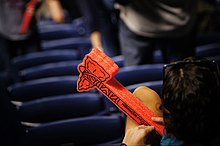
The Atlanta Braves encouraged fans to gesture with the tomahawk chop, distributing foam tomahawks at games and other events.
Since the 1960s, the issue of Native American and First Nations names and images being used by sports teams as mascots has been the subject of increasing public controversy in the United States and Canada. This has been a period of rising Indigenous civil rights movements, and Native Americans and their supporters object to the use of images and names in a manner and context they consider derogatory. They have conducted numerous protests and tried to educate the public on this issue.
In response since the 1970s, an increasing number of secondary schools have retired such Native American names and mascots. Changes accelerated in 2020, following public awareness of institutional racism prompted by nationally covered cases of police misconduct. National attention was focused on the prominent use of names and images by professional franchises including the Washington Commanders (Redskins until July 2020) and the Cleveland Guardians (Indians until November 2021). In Canada, the Edmonton Eskimos became the Edmonton Elks in 2021. Each such change at the professional level has been followed by changes of school teams; for instance, 29 changed their names between August and December 2020. A National Congress of American Indians (NCAI) database tracks some 1,900 K-12 schools in 970 school districts with Native “themed” school mascots. (Full article...) -
Image 6
Christopher Ryan Young (born May 25, 1979) is an American former professional baseball pitcher and current general manager and president of baseball operations of the Texas Rangers since 2020. He played in Major League Baseball as a right-handed pitcher from 2000 to 2017 for the Texas Rangers, San Diego Padres, New York Mets, Seattle Mariners and the Kansas City Royals. Young was a 2007 National League (NL) All-Star player as a member of the Padres, and was a member of the 2015 World Series winning Kansas City Royals team. After his playing career, he worked for the Major League Baseball front office before becoming the general manager of the Rangers in 2020.
At the age of 25, Young made his MLB debut on August 24, 2004 with the Rangers. He had previously excelled in basketball and baseball at Highland Park High School in University Park, Texas, and Princeton University. (Full article...) -
Image 7

Sidney Eugene Bream (born August 3, 1960) is an American former professional baseball first baseman. From 1983 through 1994, he played in Major League Baseball (MLB) for the Los Angeles Dodgers (1983–85), Pittsburgh Pirates (1985–90), Atlanta Braves (1991–93), and Houston Astros (1994). He is best remembered for his game-winning run scored in the 1992 National League Championship Series (NLCS) that sent the Braves to the World Series.
After attending Liberty University, Bream was drafted by the Dodgers in 1981. Though thrice ranking among the minor league home run leaders, he batted no higher than .184 in limited playing time before getting traded to the Pirates in 1985. In Pittsburgh, he regularly played over 100 games a year for the Pirates, hitting at least 10 home runs in four full seasons (1986–88, 1990) with them. Defensively, he set an NL record for most assists in a season with 166 in 1986. After a knee injury cost him most of the 1989 season, he hit 15 home runs in 1990 as the Pirates reached the playoffs, losing to the Cincinnati Reds in the NLCS. (Full article...) -
Image 8
Denton True "Cy" Young (March 29, 1867 – November 4, 1955) was an American Major League Baseball (MLB) pitcher. Born in Gilmore, Ohio, he worked on his family's farm as a youth before starting his professional baseball career. Young entered the major leagues in 1890 with the National League's Cleveland Spiders and pitched for them until 1898. He was then transferred to the St. Louis Cardinals franchise. In 1901, Young jumped to the American League and played for the Boston Red Sox franchise until 1908, helping them win the 1903 World Series. He finished his career with the Cleveland Naps and Boston Rustlers, retiring in 1911.
Young was one of the hardest-throwing pitchers in the game early in his career. After his speed diminished, he relied more on his control and remained effective into his forties. By the time Young retired, he had established numerous pitching records, some of which have stood for over a century. He holds MLB records for the most career wins, with 511, along with most career losses, earned runs, hits allowed, innings pitched, games started, batters faced, and complete games. He led his league in wins during five seasons and pitched three no-hitters, including a perfect game in 1904. (Full article...) -
Image 9
Odúbel David Herrera Jr. (/oʊˈduːbʌl ɛərˈɛərə/ oh-DOO-bull air-RAIR-uh; born December 29, 1991) is a Venezuelan professional baseball center fielder for the Pericos de Puebla of the Mexican League. He has previously played in Major League Baseball (MLB) for the Philadelphia Phillies.
Herrera grew up in Zulia, Venezuela, receiving the nickname "El Torito" (the little bull) from his father as a young baseball player. The Texas Rangers of MLB signed him as an international free agent in 2008, and he began playing the following year in the Dominican Summer League. Herrera spent the next several seasons rising through the Rangers' farm system, including back-to-back Texas League Midseason All-Star honors in 2013 and 2014. The Phillies selected Herrera in December 2014 during the Rule 5 draft. At that point, he had played most of his career at second base, but the Phillies were interested in his potential as an outfielder, and he made the opening day roster in 2015. (Full article...) -
Image 10
Howard Earle "Twink" Twining (May 30, 1894 – June 14, 1973) was an American professional baseball pitcher who played one game in Major League Baseball (MLB) for the Cincinnati Reds. He played baseball and basketball at Swarthmore College and later became a prominent dermatologist. (Full article...) -
Image 11The Calgary Cannons were a minor league baseball team located in Calgary, Alberta, for 18 seasons, from 1985 until 2002. They were a member of the AAA Pacific Coast League (PCL) and played at Foothills Stadium. The Cannons displaced the Calgary Expos, who played in the rookie level Pioneer League from 1977 until 1984. The team was previously known as the Salt Lake City Gulls before being relocated to Calgary. Following the 2002 season, the team moved to Albuquerque, New Mexico, where they became the Isotopes.
The Cannons played 2,538 regular season games in Calgary, compiling a record of 1,225–1,308. They qualified for the playoffs five times: 1985, 1987, 1989, and 1991 as an affiliate of the Seattle Mariners, and 1998 as an affiliate of the Chicago White Sox. They reached the PCL Championship Series three times, in 1987, 1991, and 1998, though they never won a title. (Full article...) -
Image 12

James Bentley "Cy" Seymour (December 9, 1872 – September 20, 1919) was an American professional baseball center fielder and pitcher, who played in Major League Baseball (MLB) from 1896 to 1913 for the New York Giants (1896–1900; 1906–1910), Baltimore Orioles (1901–1902), Cincinnati Reds (1902–1906) and Boston Braves (1913). He batted and threw left-handed.
Primarily a center fielder, Seymour retired with 1,724 hits and a lifetime batting average (BA) of .303. He was a pitcher for his first five seasons, ending his MLB career with a 61–56 win–loss record and a 3.76 earned run average (ERA) in 140 games pitched (123 as a starting pitcher). Seymour is the only player apart from Babe Ruth to finish his career with at least 50 home runs (HR) and 50 pitching wins. Seymour is the Reds' career leader in batting average (.332) and holds the Reds' single-season record for batting average (.377 in 1905). (Full article...) -
Image 13

WPSG (channel 57), branded Philly 57, is an independent television station in Philadelphia, Pennsylvania, United States. It is owned by the CBS News and Stations group alongside CBS outlet KYW-TV (channel 3). The two stations share studios on Hamilton Street north of Center City Philadelphia; WPSG's transmitter is located in the city's Roxborough section.
Channel 57 was allocated for commercial use in Philadelphia at the start of the 1970s; it was fought over by two groups who sought to broadcast subscription television (STV) programming to paying customers in the metropolitan area. Radio Broadcasting Company prevailed and launched WWSG-TV on June 15, 1981. It offered limited financial news programming, which was abandoned after 18 months, and a subscription service utilizing programming from SelecTV. Two years later, the station switched to broadcasting PRISM, a premium regional sports and movies service seeking to reach potential subscribers in areas beyond cable coverage, such as the city of Philadelphia. (Full article...) -
Image 14
Wilbur Forrester Wood Jr. (born October 22, 1941) is an American former professional baseball pitcher. In a 17-year Major League Baseball (MLB) career, he pitched for the Boston Red Sox (1961–64), the Pittsburgh Pirates (1964–65), and the Chicago White Sox (1967–78). A knuckleball specialist after joining the White Sox, he threw left-handed and batted right-handed.
Raised in Belmont, Massachusetts, Wood played several sports in high school and was signed by his hometown Boston Red Sox in 1960. He pitched sparingly for them over parts of four seasons before being traded to the Pittsburgh Pirates in 1964. Seldom-used by the team in 1965, he spent all of 1966 in the minor leagues before being traded to the White Sox. Wood, who had previously relied on a fastball and curveball, refined the knuckleball with the help of veteran knuckleball specialist Hoyt Wilhelm. He spent the next four seasons as a relief pitcher for Chicago. In 1968, he set a record (broken the next year) with 88 games pitched and was named the Sporting News American League (AL) Fireman of the Year. (Full article...) -
Image 15
The statue following its 2009 recovery from the river
The Curse of the Colonel (Japanese: カーネルサンダースの呪い, romanisation: Kāneru Sandāsu no Noroi) is a Japanese urban legend that holds that the ghost of the KFC founder, Colonel Sanders, placed a curse on the Hanshin Tigers baseball team.
The curse was said to be placed on the team because of the Colonel's anger over treatment of one of his store-front statues, which was thrown into the Dōtonbori River by Hanshin fans before their team's 1985 Central League pennant. As is common with sports curses, the Curse of the Colonel was used to explain the team's lack of success in subsequent years. Some fans believed the team would never win another Japan Series until the statue was recovered. They appeared in the Japan Series three more times and lost in 2003, 2005 and 2014 before winning in 2023. (Full article...)
Did you know (auto-generated) - load new batch

- ... that before his Major League Baseball career, Leo Posada represented Cuba internationally in cycling?
- ... that the ownership group of San Diego's MLS team includes a Native American tribe and baseball player Manny Machado?
- ... that Genevieve Beacom became the first woman to pitch in the Australian Baseball League when she made her debut for the Melbourne Aces in 2022?
- ... that baseball player Mark Littell developed an anatomically correct athletic cup called the "Nutty Buddy"?
- ... that after he retired from professional baseball, Paul Hinrichs became a Lutheran minister?
- ... that Kelsie Whitmore was part of the first all-female battery in a professional baseball league since the All-American Girls Professional Baseball League?
- ... that Gil Kim played professional baseball in the Netherlands, China, Australia, Spain, and Venezuela, scouted in Mexico and the Dominican Republic, and coaches in Canada?
- ... that before he made his Major League Baseball debut, Nate Fisher worked as a commercial lending analyst for the First National Bank of Omaha?
Quotes
| If you're going to play at all, you're out to win. Baseball, board games, playing Jeopardy!, I hate to lose.'' |
 Featured lists - load new batch
Featured lists - load new batch
-
Image 1First-round selections Ken Griffey Jr. (top left), Mike Harkey (top right), Jack McDowell (bottom left), and Mike Remlinger (bottom right).
The 1987 Major League Baseball draft is the process by which Major League Baseball (MLB) teams select athletes to play for their organization. High school seniors, college juniors and seniors, and anyone who had never played under a professional contract were considered eligible for the draft. The 1987 MLB Draft took place as a conference call to the Commissioner of Baseball's office in New York from June 2–4. As opposed to the National Football League Draft which appeared on ESPN, no network aired the MLB Draft.
The American League (AL) and the National League (NL) alternated picks throughout the first round; because an NL team drafted first in the 1986 MLB Draft, an AL team had the first selection in 1987. Having finished 67–95 in 1986, the Seattle Mariners had the worst record in the AL and thus obtained the first overall selection. The second selection went to the Pittsburgh Pirates, who had the worst record in the NL. (Full article...) -
Image 2The 1971 Cy Young Award won by Ferguson Jenkins, on display in the Canadian Baseball Hall of Fame
The Cy Young Award is given annually to the best pitchers in Major League Baseball (MLB), one each for the American League (AL) and National League (NL). The award was introduced in 1956 by Baseball Commissioner Ford C. Frick in honor of Hall of Fame pitcher Cy Young, who died in 1955. The award was originally given to the single best pitcher in the major leagues, but in 1967, after the retirement of Frick, the award was given to one pitcher in each league.
Each league's award is voted on by members of the Baseball Writers' Association of America (BBWAA). Local BBWAA chapter chairmen in each MLB city recommend two writers to vote for each award. Final approval comes from the BBWAA national secretrary-treasurer. Writers vote for either the American League or National League awards, depending on the league in which their local team plays. A total of 30 writers vote for each league's awards. Writers cast their votes prior to the start of postseason play. (Full article...) -
Image 3

Mike Scioscia (1976) won championships with the Dodgers in 1981 and 1988.
The Los Angeles Dodgers are a Major League Baseball (MLB) franchise based in Los Angeles, California. They play in the National League West division. Since the institution of MLB's Rule 4 Draft, the Dodgers have selected 67 players in the first round. Officially known as the "First-Year Player Draft", the Rule 4 Draft is MLB's primary mechanism for assigning players from high schools, colleges, and other amateur clubs to its franchises. The draft order is determined based on the previous season's standings, with the team possessing the worst record receiving the first pick. In addition, teams which lost free agents in the previous off-season may be awarded compensatory or supplementary picks.
Of the 67 players picked in the first round by Los Angeles, 37 have been pitchers, the most of any position; 24 of these were right-handed, while 12 were left-handed. Nine players at shortstop and nine in the outfield were selected, while five catchers, three first basemen, and three third basemen were taken as well. The team also selected two players at second base. Seven of the players came from high schools or universities in the state of Texas, while California follows with six players. (Full article...) -
Image 4The San Diego Padres are an American professional baseball team based in San Diego. The Padres compete in Major League Baseball (MLB) as a member club of the National League (NL) West Division. The team joined MLB in 1969 as an expansion team and have won two NL Championships, in 1984 and 1998. The team played their home games at San Diego Stadium from 1969 to 2003. Starting with the 2004 season, they moved to Petco Park, where they have played since. The team is owned by the estate of Peter Seidler, and A. J. Preller is their general manager. There have been 21 managers for the Padres franchise. The team is currently managed by Mike Shildt.
The first manager of the Padres was Preston Gómez, who managed for four seasons. Bruce Bochy is the franchise's all-time leader for the most regular-season games managed (1926), the most regular-season game wins (951), the most playoff games managed (24), and the most playoff-game wins (8). Bob Skinner is the Padres' all-time leader for the highest regular-season winning percentage, as he has only managed one game, which he won. Of the managers who have managed a minimum of 162 games (one season), Jack McKeon has the highest regular-season winning percentage with .541, having managed for 357 games. Dick Williams, the only Padres manager to have been elected into the Baseball Hall of Fame, is the franchise's all-time leader for the highest playoff winning percentage with .400. Williams and Bochy are the only managers to have won an NL Championship with the Padres, in 1984 and 1998 respectively. Bochy and Black are the only managers to have won a Manager of the Year Award with the Padres, in 1996 and 2010. Greg Riddoch and Jerry Coleman have spent their entire managing careers with the Padres. (Full article...) -
Image 5
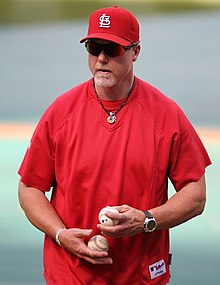
In Major League Baseball (MLB), the 50 home run club is the group of batters who have hit 50 or more home runs in a single season. Babe Ruth was the first to achieve this, doing so in 1920. By reaching the milestone, he also became the first player to hit 30 and then 40 home runs in a single season, breaking his own record of 29 from the 1919 season. Ruth subsequently became the first player to reach the 50 home run club on four occasions, repeating the achievement in 1921, 1927, and 1928. He remained the only player to accomplish this until Mark McGwire and Sammy Sosa matched his feat in 1999 and 2001, respectively. In doing so, they became the only players to have achieved 50 home runs in four consecutive seasons. Barry Bonds hit the most home runs to join the club, collecting 73 in 2001. The most recent player to hit 50 home runs in three seasons is Aaron Judge, who did so in 2024.
In total, 32 players have reached the 50 home run club in MLB history and ten have done so more than once. Of these, seventeen were right-handed batters, fourteen were left-handed, and one was a switch hitter, meaning he could bat from either side of the plate. Four of these players (including two active members of the 50 home run club) have played for only one major league team. The New York Yankees are the only franchise to have five players reach the milestone while on their roster: Ruth, Mickey Mantle, Roger Maris, Alex Rodriguez, and Aaron Judge. Ten players are also members of the 500 home run club and two of them (Willie Mays and Rodriguez) are also members of the 3,000 hit club. Ten players won the Most Valuable Player (MVP) Award in the same year as their 50 home run season. Mantle is the only player to have earned the Major League Triple Crown alongside achieving 50 home runs, leading both leagues in batting average, home runs and runs batted in (RBI). Mantle and Maris—collectively known as the M&M Boys—are the only teammates to reach the 50 home run club in the same season, hitting a combined 115 home runs in 1961 and breaking the single-season record for home runs by a pair of teammates. Albert Belle is the only player to amass 50 or more doubles in addition to attaining 50 home runs. Prince Fielder, at 23 years and 139 days, was the youngest player to reach the milestone while Bonds, at age 37, was the oldest. Pete Alonso and Aaron Judge are the only players to hit 50 home runs in their rookie seasons. (Full article...) -
Image 6

Eddie Guardado, a pitcher for the 1993 Xpress, was called up after 10 starts to make his MLB debut with the Minnesota Twins on June 13, 1993.
The Nashville Xpress Minor League Baseball team played two seasons in Nashville, Tennessee, from 1993 to 1994 as the Double-A affiliate of the Minnesota Twins. In those seasons, a total of 60 players competed in at least one game for the Xpress. The 1993 roster included a total of 35 players, while 38 played for the team in 1994. There were 13 players who were members of the team in both seasons. Of the 60 all-time Xpress players, 22 also played in at least one game for a Major League Baseball (MLB) team during their careers.
After the 1992 baseball season, Charlotte, North Carolina, home of the Double-A Southern League's Charlotte Knights, acquired a Triple-A expansion team in the International League, leaving the Southern League franchise in need of a new home. Larry Schmittou, president of the Triple-A Nashville Sounds, offered Herschel Greer Stadium as a temporary home for the displaced team until owner George Shinn could find a permanent home for his club. Upon the league's approval, the franchise relocated to Nashville and became the Nashville Xpress. In order to accommodate two teams at Greer, the Xpress' games were scheduled for during the Sounds' road trips. (Full article...) -
Image 7

Clayton Kershaw holds the Dodgers' record for most Opening Day starts with nine (2011–2018 & 2021).
The Los Angeles Dodgers are a Major League Baseball (MLB) franchise based in Los Angeles. They play in the National League West division. The first game of the new baseball season for a team is played on Opening Day, and being named the Opening Day starter is an honor, which is often given to the player who is expected to lead the pitching staff that season, though there are various strategic reasons why a team's best pitcher might not start on Opening Day. The Dodgers have used 26 different Opening Day starting pitchers in their 67 seasons in Los Angeles. The 26 starters have a combined Opening Day record of 29 wins, 27 losses and 10 no decisions.
The Dodgers started playing in Los Angeles in 1958, after moving from Brooklyn. The first Opening Day game for the Dodgers in Los Angeles was played in San Francisco against the San Francisco Giants on April 15, 1958. California native Don Drysdale was the Dodgers' Opening Day starting pitcher that day, in a game the Dodgers lost 8–0. Dodgers starting pitchers won both of their Opening Day starts in their first home ballpark in Los Angeles, Los Angeles Memorial Coliseum. (Full article...) -
Image 8
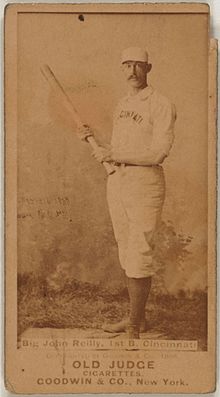
In baseball, completing the cycle is the accomplishment of hitting a single, a double, a triple, and a home run in the same game. In terms of frequency, the cycle is roughly as common as a no-hitter; Baseball Digest calls it "one of the rarest feats in baseball". Collecting the hits in the listed order is known as a "natural cycle".
The cycle itself is semi-rare in Major League Baseball (MLB), having occurred a total of 348 times, starting with Curry Foley in 1882, through Weston Wilson on August 15, 2024. A natural cycle has been completed 14 times in modern MLB history, most recently by Gary Matthews Jr. of the Texas Rangers in 2006. (Full article...) -
Image 9

Barry Larkin is the Silver Slugger Award leader among shortstops, with nine wins.
The Silver Slugger Award is awarded annually to the best offensive player at each position in both the American League (AL) and the National League (NL), as determined by the coaches and managers of Major League Baseball (MLB). These voters consider several offensive categories in selecting the winners, including batting average, slugging percentage and on-base percentage, in addition to "coaches' and managers' general impressions of a player's overall offensive value." Managers and coaches are not permitted to vote for players on their own team. The Silver Slugger was first awarded in 1980 and is given by Hillerich & Bradsby, the manufacturer of Louisville Slugger bats. The award is a bat-shaped trophy, 3 feet (91 cm) tall, engraved with the names of each of the winners from the league and plated with sterling silver.
Among shortstops, Barry Larkin is the leader in Silver Slugger Awards, with nine wins between 1988 and 1999, including five consecutive awards (1988–1992). Larkin is fourth all-time in Silver Slugger wins among all positions, behind outfielder Barry Bonds, catcher Mike Piazza and third baseman Alex Rodriguez, who won his first seven awards at shortstop before a position change. Hall of Famer Cal Ripken Jr. won eight Silver Sluggers as a shortstop from 1983 to 1993. Derek Jeter (2006–2009; 2012) and Xander Bogaerts (2015–2016; 2019; 2021–2022) each won five Silver Sluggers as a shortstop, while Ian Desmond (2012–2014), Alan Trammell (1987–1988, 1990), and Édgar Rentería (2000; 2002–2003) won three. Francisco Lindor (2017–2018; 2023) and Corey Seager (2016–2017; 2023) each won three Silver Slugger Awards at shortstop across two different leagues. (Full article...) -
Image 10

Barry Bonds has won 12 Silver Slugger Awards, the most of any player at any position.
The Silver Slugger Award is awarded annually to the best offensive player at each position in both the American League (AL) and the National League (NL), as determined by the coaches and managers of Major League Baseball (MLB). These voters consider several offensive categories in selecting the winners, including batting average, slugging percentage, and on-base percentage, in addition to "coaches' and managers' general impressions of a player's overall offensive value". Managers and coaches are not permitted to vote for players on their own team. The Silver Slugger was first awarded in 1980 and is given by Hillerich & Bradsby, the manufacturer of Louisville Slugger bats. The award is a bat-shaped trophy, 3 feet (91 cm) tall, engraved with the names of each of the winners from the league and plated with sterling silver.
As with the Rawlings Gold Glove Award, the prize is presented to outfielders irrespective of their specific position. This means that it is possible for three left fielders, or any other combination of outfielders, to win the award in the same year, rather than one left fielder, one center fielder, and one right fielder. It is also possible for outfield teammates to win the award in the same season, which has happened eight times since 1980. (Full article...) -
Image 11
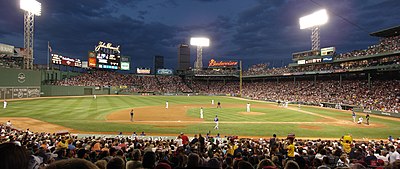
Fenway Park, Boston's home ballpark since 1912
The Boston Red Sox are a Major League Baseball (MLB) franchise based in Boston, Massachusetts. They have played in the American League since it was founded in 1901, and the American League East since divisions were introduced in 1969. The first game of each baseball season for a team is known as Opening Day, for which being named the starting pitcher is an honor. That honor is often given to the player who is expected to lead the pitching staff that season, although there are various strategic reasons why a team's best pitcher might not start on Opening Day. (Full article...) -
Image 12
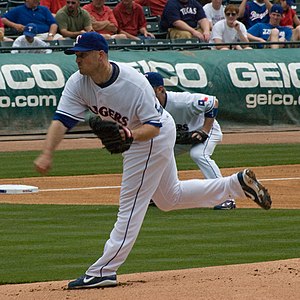
Jason Jennings is the only one of Rockies first-round draft picks to win the Rookie of the Year Award (2002).
The Colorado Rockies are a Major League Baseball (MLB) franchise based in Denver, Colorado. They play in the National League West division. The Rockies have participated in MLB's annual June draft since 1992. Officially known as the "First-Year Player Draft", the Rule 4 Draft is MLB's primary mechanism for assigning players from high schools, colleges, and other amateur clubs to its franchises. The draft order is determined based on the previous season's standings, with the team possessing the worst record receiving the first pick. In addition, teams which lost free agents in the previous off-season may be awarded compensatory or supplementary picks. Since the franchise was established as an expansion team in 1992, the Rockies have selected 31 players in the first round. The First-Year Player Draft is unrelated to the 1992 expansion draft through which the Rockies filled their roster.
Of the 31 players selected in the first round by the Rockies, 18 have been pitchers, the most of any position; 12 of these have been right handed, and 6 have been left-handed. The Rockies have also selected six outfielders, four shortstops, and one player each at catcher, first base, and third base. The Rockies have never selected a second baseman in the first round. The Rockies have drafted 16 players out of high school, and 14 out of college. Colorado has drafted seven players from high schools or colleges in the state of California, with five coming from Texas and three from Tennessee. The Rockies' 2002 selection—Jeff Francis—is the only selection from outside the United States.
None of the Rockies' first-round picks have won a World Series championship with the team. One pick has been elected to the Hall of Fame, Todd Helton who was the 8th overall pick in 1995. The Rockies' first-round selection in 1999—Jason Jennings—won the MLB Rookie of the Year award with the franchise in 2002, his first full season in the Major Leagues. Todd Helton—the Rockies' 1995 selection—has won four Silver Slugger Awards and three Gold Gloves, as well as being named to five All-Star teams. Casey Weathers, the Rockies' 2007 selection, won a bronze medal in baseball with the United States team at the 2008 Summer Olympics. The Rockies have never held the first overall pick in the draft, but held the second overall pick once, which they used in 2006 to select Greg Reynolds. (Full article...) -
Image 13Statistics current through October 9, 2024 (Full article...)
-
Image 14The Pittsburgh Pirates are a Major League Baseball (MLB) franchise based in Pittsburgh, Pennsylvania. They play in the National League Central division. Since the establishment of the Rule 4 Draft the Pirates have selected 72 players in the first round. Officially known as the "First-Year Player Draft", the Rule 4 Draft is MLB's primary mechanism for assigning players from high schools, colleges, and other amateur clubs to its franchises. The draft order is determined based on the previous season's standings, with the team possessing the worst record receiving the first pick. In addition, teams which lost free agents in the previous off-season may be awarded compensatory or supplementary picks.
Of these 72 players, 27 have been pitchers, the most of any position; 20 of these were right-handed, while 7 were left-handed. 17 outfielders and 15 shortstops were selected. The Pirates have also drafted 7 catchers, 3 first basemen, and 3 third basemen, but have never selected a second baseman in the first round. Eleven players came from high schools or universities in the state of California, while eight came from Florida. (Full article...) -
Image 15

Iván Rodríguez has won 13 Gold Gloves, the most among catchers.
The Rawlings Gold Glove Award, usually referred to as the Gold Glove, is the award given annually to the Major League Baseball players judged to have exhibited superior individual fielding performances at each fielding position in both the National League (NL) and the American League (AL), as voted by the managers and coaches in each league. Managers are not permitted to vote for their own players. Eighteen Gold Gloves are awarded each year (with the exception of 1957, 1985, 2007 and 2018), one at each of the nine positions in each league. In 1957, the baseball glove manufacturer Rawlings created the Gold Glove Award to commemorate the best fielding performance at each position. The award was created from a glove made from gold lamé-tanned leather and affixed to a walnut base. Initially, only one Gold Glove per position was awarded to the top fielder at each position in the entire league; however, separate awards were given for the National and American Leagues beginning in 1958.
Iván Rodríguez has won the most Gold Gloves at catcher, with 13; all were won with the Texas Rangers or the Detroit Tigers (both American League teams), though Rodríguez has played in both leagues. Johnny Bench, who spent his entire career with the Cincinnati Reds, leads National Leaguers in wins, and is second overall with 10 Gold Gloves. Yadier Molina is third overall and second in the NL all time with nine. Bob Boone, who is a member of one of four family pairs to win Gold Glove Awards, won seven between both leagues during his career. Jim Sundberg has won six Gold Gloves, with Bill Freehan and Salvador Pérez winning five. There have been four 4-time winners at catcher: Del Crandall, Mike Matheny, Charles Johnson, and Tony Peña. Hall of Famers who have won as catchers include Bench, Rodriguez, Carlton Fisk, and Gary Carter.[d] The other family pair to win Gold Gloves as catchers are brothers Bengie and Yadier Molina, who have won eleven awards between them as of the end of the 2018 season[update]. (Full article...)
More did you know
- ... that the San Francisco Giants drafted Brock Bond when they meant to draft Casey Bond?
- ... that Eddie Gillette led the Wisconsin Badgers football team to an undefeated season and in baseball "beat some of the best pitchers in the 'Three-Eye League'"?
- ... that the 2005 book Baseball Before We Knew It brought new evidence of the origins of baseball into play?
- ... that in baseball, no Gold Glove Award-winning catcher posted an errorless season until Charles Johnson and Mike Matheny accomplished the feat twice in six years?
- ... that Bob "Horse" Reynolds founded the Los Angeles Angels baseball team and was inducted into the College Football Hall of Fame within a year?
- ... that Red Snapp was considered the "king of the minor leagues"?
Sports portals
Selected picture

| Credit: User:Braindrain0000 |
Major League Baseball has several blackout rules. Games are blacked out based on two criteria:
- A local broadcaster has priority to televise games of the team in their market over national broadcasters.
- FOX has certain rights for afternoon MLB games on Saturdays, and ESPN has the same rights for night games on Sundays.
Associated Wikimedia
The following Wikimedia Foundation sister projects provide more on this subject:
-
Commons
Free media repository -
Wikibooks
Free textbooks and manuals -
Wikidata
Free knowledge base -
Wikinews
Free-content news -
Wikiquote
Collection of quotations -
Wikisource
Free-content library -
Wikiversity
Free learning tools -
Wiktionary
Dictionary and thesaurus
More portals
- Portals with triaged subpages from June 2018
- All portals with triaged subpages
- Portals with no named maintainer
- Automated article-slideshow portals with 51–100 articles in article list
- Automated article-slideshow portals with 501–1000 articles in article list
- Random portal component with 41–50 available subpages
- Automated article-slideshow portals with 201–500 articles in article list
- Random portal component with 11–15 available subpages
- Random portal component with 21–25 available image subpages



